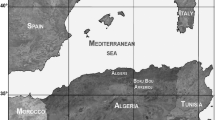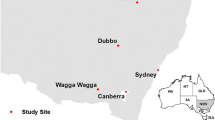Abstract
The potential of crop yields illustrates the possibilities of increasing their production in the future. Modeling of potential yield of winter wheat on the European part of Russia was conducted based on specially developed GIS and the WOFOST crop growth simulation model. It was found that the winter wheat yield for Russia in general can be increased by 70% in the modern climatic conditions. The maximal potential for yield increasing was found in the regions situated on the Northern edge of the crop cultivation. In the Northern Caucasus, real crop yield is close to the climatic maximum; however, due to large crop acreage in Krasnodar krai, Stavropol krai, and Rostov and Volgograd oblasts, wheat harvest in each region can still be increased by 1–3 mln tons in each of them.
Similar content being viewed by others
References
Tilman, D., Cassman, K.G., Matson, P.A., Naylor, R., and Polasky, S., Agricultural sustainability and intensive production practices, Nature, 2002, vol. 418, pp. 671–677.
Ray, D.K., Mueller, N.D., West, P.C., and Foley, J.A., Yield Trends Are Insufficient to Double Global Crop Production by 2050, PLoS ONE, 2013, vol. 8.
Ulanova, E.S., Agrometeorologicheskie usloviya i urozhainost' ozimoi pshenitsy (Agrometeorological Conditions and Productivity of Winter Wheat), Leningrad: Gidrometeoizdat, 1975.
Sirotenko, O.D., The KLIMAT-UROZHAI simulation system in the USSR, Meteorol. Gidrol., 1991, no. 4, pp. 67–73.
Shatilov, N.S. and Chudnovskii, A.F., Agrofizicheskie, agrometeorologicheskie i agrotekhnicheskie osnovy programmirovaniya urozhaya (Agrophysical, Agrometeorological and Agrotechnical Fundamentals of Crop Programming), Leningrad: Gidrometeoizdat, 1980.
Schierhorn, F., Faramarzi, R., Prishchepov, A.V., Koch, F.J., and Muller, D., Quantifying yield gaps in wheat production in Russia, Environ. Res. Lett., 2014, vol. 9, pp. 084017. doi 10.1088/1748-9326/9/8/0840177
Fischer, G., Shah, M., and van Velthuizen, H., Climate Change and Agricultural Vulnerability. IIASA Special Report commissioned by the UNfor the World Summit on Sustainable Development, Johannesburg, 2002.
Mueller, N.D., Gerber, J.S., Johnston, M., Ray, D.K., Ramankutty, N., and Foley, J.A., Closing yield gaps through nutrient and water management, Nature, 2012, vol. 490, pp. 254–257. doi 10.1038/nature11420
Edinyi gosudarstvennyi reestr pochvennykh resursov Rossii. Versiya 1.0. Kollektivnaya monografiya (The Unified State Register of Soil Resources of Russia. Version 1.0. Collective Monograph), Moscow: Pochvennyi institut im. V.V.Dokuchaeva, 2014.
Stolbovoi, V.S., Savin, I.Yu., Sheremet, B.V., Sizov, V.V., and Ovechkin, S.V., The geoinformation system of soil degradation in Russia, Pochvovedenie, 1999, vol. 5, pp. 646–651.
Lupyan, E.A., Bartalev, S.A., and Savin, I.Yu., Technologies of satellite monitoring in agriculture of Russia, Aerokosm. Kur’er, 2009, no. 6, pp. 47–49.
Savin, I.Yu., Stolbovoi, V.S., and Diepen, K., Imitatsionnaya model' rosta sel’skokhozyaistvennykh rastenii WOFOST i ee ispol’zovanie dlya analiza produktivnosti zemel' Rossii (The Simulation Model of Growth of Agricultural Plants WOFOST and Its Use for Analysis of Productivity of Lands of Russia), Moscow: Rossel’khozakademiya, 2001.
Supit, I., Hooijer, A.A., and van Diepen, C.A., System Description of the WOFOST 6.0 Crop Growth Simulation Model, Brussels, Luxembourg: Joint Research Centre, Commission of the European Communities, 1994.
Keulen, H. and Wolf, J., Modeling of agricultural production: Weather, soils and crops, in Simulation Monographs, Pudoc, Wageningen, 1986.
Donatelli, M., Duveill, G., Fumagalli, D., Srivastava, A., Zucchini, F., Angileri, V., Fasbender, D., Loudjani, P., Kay, S., Juskevicius, V., Toth, T., Haastrup, P., M’ barek, R., Espinosa, M., Ciaian, P., and Niemeyer, S., Assessing Agriculture Vulnerabilities for the Design of Effective Measures for Adaptation to Climate Change (AVEMAC Project), Luxembourg: Publications Office of the European Union, 2012.
Author information
Authors and Affiliations
Corresponding author
Additional information
Original Russian Text © I.Yu. Savin, V.S. Stolbovoy, N.V. Savitskaya, 2017, published in Rossiiskaya Sel’skokhozyaistvennaya Nauka, 2017, No. 3, pp. 17–20.
About this article
Cite this article
Savin, I.Y., Stolbovoy, V.S. & Savitskaya, N.V. Climatic potential for winter wheat yield in Russia. Russ. Agricult. Sci. 43, 296–299 (2017). https://doi.org/10.3103/S1068367417040127
Received:
Published:
Issue Date:
DOI: https://doi.org/10.3103/S1068367417040127




